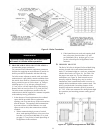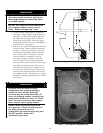
12
GNINRAW
fongisedehtnotrepxegnitnevatlusnoC.ylnosnoitadnemmocererasnoitcurtsnIgnitneV
lanoitaNehTdnaediuGgnitneVEARHSAehT.noitacilpparuoyrofmetsystnevcificepsa
.smetsysgnitnevllanideredisnocebdluohs45APFN,edoCsaGleuF
kaelnacsesageulF.noitacilppaehtrofelbatiusebtonyamlairetamtnevlanoitnevnoC
yrujnilanosreperevesnitlusernacdnaslairetamesehtnostniojehtmorfedixonomnobrac
.htaedro
lliwswobleroseetfotnuomaevissecxenarosnurlatnozirohgnolgnivahsnoitallatsnI
foegakaelsageulf,noitasnednocnitlusernacdnasesagnoitsubmocfowolfehttcirtser
.htaedroyrujnilanosreperevesnignitluser,edixonomnobrac
If the venting system is designed for positive or forced
draft venting, the boiler, vent connector and stack will
operate under positive pressure. Gas tight vent systems
designed for pressure systems must be used to prevent
flue by-product leakage. The vent height is usually
limited to prevent negative draft, typically three (3)
feet above the roof line (see Figure 3a). The damper
shall be adjusted to maintain a positive pressure of 0.1”
W.C. in the vent connector box during burner high fire
operation (see breeching pressure sensing port in Figure
1).
If the venting system is designed for negative pressure
(natural draft), the boiler still operates with positive
pressure in the chamber and up to the fixed damper on
the flue collar. However, if the venting system is larger
than what is required, the stack will provide a surplus
draft (or negative pressure) that may require the use of
a barometric damper to maintain the positive 0.1” W.C.
pressure at the flue outlet. Multiple forced draft boiler
stacks should always be designed as negative to ensure
the products of combustion do not exit a boiler that is
not firing.
FIGURE 3b: VENTS — FAULTS & SUGGESTIONS
TYPICAL VENTS THAT ARE USED ON FORCED DRAFT BOILERS, ON LOW SILHOUETTE BUILDINGS
VENT SIZING - Area must be the same as or greater than the boiler breeching (Smoke Outlet). A barometric damper may be required on
installations with a high draft condition.
FAULTY BOILER BURNER OPERATION
1. If improper vent is suspected, remove pipe at breeching and operate boiler. This will determine if excessive down draft,
blocked or restricted flue, etc. is causing the problem.
2. If using type shown in A above, be sure cap is raised sufficiently above main pipe to allow flue gases to vent unimpeded.
3. A popular type cap is shown in B.
4. The tee is frequently used as shown in C.
5. D and E should not be used due to possible fl
uctuations in back pressure.
B
RAIN CAP
RIGHT
“A” CAP
RIGHT
TEE TYPE
RIGHT
D
E
WRONG
WRONG
90°
ELBOW
UP or DOWN
A
C


















